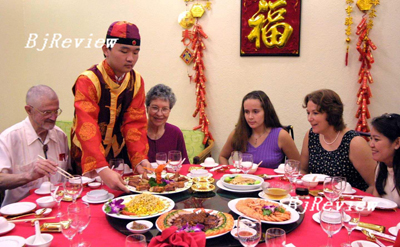
Like most Americans, my experience with stateside Chinese food was limited the stuff we get delivered in cleverly folded cardboard tubs. Although I enjoyed my weekly mu-shu fix, I did harbor suspicions that it was not, perhaps, the most authentic culinary experience. Thus, I came to China ready for unfamiliar ingredients, determined to develop a taste for real Chinese cuisine. But my first glimpse of Chinese cooking culture actually came about a year prior to hopping my trans-Pacific flight.
Long before whetting America's appetite for period China and Zhang Ziyi, Crouching Tiger, Hidden Dragon director Ang Lee made an unassuming drama called Eat Drink Man Woman. The story centers on a widowed Taipei chef who struggles to hold his family together by doing the only thing he knows, cooking. With no dialogue to distract, the first five minutes follow the chef as he slices, steams, seasons, stir fries and otherwise seduces any viewer with functional taste buds.
When I rented a Chinese cooking movie, I certainly expected to see dishes I was unfamiliar with. What I did not expect was that the techniques would be just as exotic. I was captivated by the way the chef used his myriad cleavers, woks and steamers, so different from what I'd seen in Western kitchens. I knew in my heart and in my stomach that I had to learn more about Chinese cuisine.
Conveniently, nine months later I found myself buying a one-way ticket to Hohhot, the capital of Inner Mongolia Autonomous Region. Within a week I'd sampled Mongolian hotpot (with paper-thin lamb, a delicate ginger and date broth, and vegetables I couldn't put a name to), naicha (salty Mongolian milk tea, served steaming in soup bowls) and more kinds of tofu than I had even believed possible. I had not anticipated the Chinese penchant for eating out, but I knew immediately that restaurants, from squalid to swanky, were going to be the learning experience I was looking for.
Lesson number one: China does not have a food pyramid. The first time we were served potato noodles with bowls of rice on the side, my culinary sensibilities went into starch overload. I was immediately reminded of another food film, Big Night, where an Italian chef nearly expels two customers after they ask for a side of spaghetti with their risotto. After 23 years of eating meals with at least a nod to a carb-protein balance, I found myself adjusting my ideas of what foods belonged together. Adjustments, which, I soon discovered, had not gone far enough.
My Chinese friends were excited by my enthusiasm for trying new foods, and thus took pleasure in ordering on my behalf. Not that I was complaining, as I couldn't read the menus, but lunch one day with my Chinese friend Jackie sparked a conversation about culinary preconceptions. As we sat in Xiao PangPang's, my favorite local restaurant, she ordered chaobing (fried strips of dough with pork and vegetables) and basi naipi (essentially, donuts).
When the waiter brought our meal, I laughed. I couldn't help it. Pork and donuts were not what I was expecting when I set out for new and exciting culinary horizons. Jackie looked at me quizzically, which I've grown accustomed to as her mad foreign friend, and asked what was funny. As I explained about donuts and dessert, in general, I realized I'd just arrived at lesson number two: The sweet after savory rule, immutable though it may be in the West, holds no sway at Chinese tables.
Lesson number three is certainly the most profound and was actually the result of a broader realignment in my thinking. You see, along with bulging suitcases, I brought with me to China the preconception that Chinese food was the same whether you were dining in different regions.
This myth of gastronomical homogeneity is, I think, indicative of the way that many Americans look at Chinese culture as a whole. Perhaps we imagine that 5,000 years of civilization has been enough to create a single culture to span the Middle Kingdom. Or perhaps, with our history as a country of immigrants, we think we have a monopoly on ethnic diversity. Whatever the reason, my idea of a single, cohesive culture, and therefore cuisine, was brought down by lesson number three: Chinese cuisine is not one thing, but many.
My determination to learn about Chinese cooking culture hasn't waned from that initial inspiration, watching Eat Drink Man Woman on a far distant TV set. But as my third lesson sinks in, I realize that I could eat my way through every restaurant in Inner Mongolia, and untold culinary adventures would still await me in the rest of the country. And that is a welcome lesson indeed.
The author is an American studying in Inner Mongolia |
